General
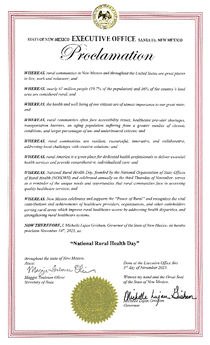 2023 Proclamation of National Rural Health Day
Primary Care & Rural Health - General
November 7, 2023
2023 Proclamation of National Rural Health Day
Primary Care & Rural Health - General
November 7, 2023
2023 Proclamation of National Rural Health Day
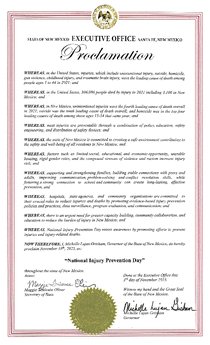 2023 Proclamation of National Injury Prevention Day
Injury Prevention - General
November 6, 2023
2023 Proclamation of National Injury Prevention Day
Injury Prevention - General
November 6, 2023
2023 Proclamation of National Injury Prevention Day
 New Mexico Department of Health Announces Start of Influenza (Flu) Season 2023-2024
Health Emergency Management - General
November 1, 2023
New Mexico Department of Health Announces Start of Influenza (Flu) Season 2023-2024
Health Emergency Management - General
November 1, 2023
New Mexico Department of Health Announces Start of Influenza (Flu) Season
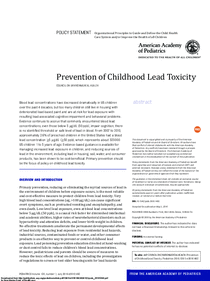 Prevention of Childhood Lead Toxicity
Lead Poisoning Prevention - General
October 31, 2023
Prevention of Childhood Lead Toxicity
Lead Poisoning Prevention - General
October 31, 2023
Prevention of Childhood Lead Toxicity
 Protecting Infants from RSV during the National Nirsevimab (Beyfortus) Shortage
Health Emergency Management - General
October 31, 2023
Protecting Infants from RSV during the National Nirsevimab (Beyfortus) Shortage
Health Emergency Management - General
October 31, 2023
Protecting Infants from RSV during the National Nirsevimab (Beyfortus) Shortage
 Recommendation for Expanded Syphilis Screening to Reduce Rising Rates of Congenital Syphilis
Sexually Transmitted Diseases - General
October 30, 2023
Recommendation for Expanded Syphilis Screening to Reduce Rising Rates of Congenital Syphilis
Sexually Transmitted Diseases - General
October 30, 2023
Recommendation for Expanded Syphilis Screening to Reduce Rising Rates of Congenital Syphilis
 Increase in firearm related morbidity and mortality in New Mexico: Recommendations for preventing firearm injury, homicide and suicide
Health Emergency Management - General
October 20, 2023
Increase in firearm related morbidity and mortality in New Mexico: Recommendations for preventing firearm injury, homicide and suicide
Health Emergency Management - General
October 20, 2023
Increase in firearm related morbidity and mortality in New Mexico: Recommendations for preventing firearm injury, homicide and suicide
 Outbreak of Cryptosporidiosis Associated with Exposure to the State Fair
Health Emergency Management - General
October 5, 2023
Outbreak of Cryptosporidiosis Associated with Exposure to the State Fair
Health Emergency Management - General
October 5, 2023
The New Mexico Department of Health (NMDOH) is investigating a statewide outbreak of Cryptosporidiosis associated with exposure to petting zoo livestock at the New Mexico State Fair, which took place from September 7-17th, 2023. There have been 3 patients with laboratory-confirmed Cryptosporidiosis infections and an additional 15 clinically compatible cases who report exposure to the NM State Fair. Cases reside in multiple counties across the state.
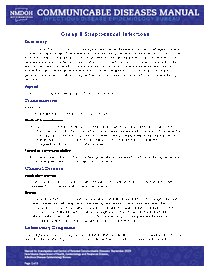 CD Manual - Streptococcal Infections (Invasive Group B)
Infectious Disease Surveillance - General
September 19, 2023
CD Manual - Streptococcal Infections (Invasive Group B)
Infectious Disease Surveillance - General
September 19, 2023
Streptococcal Infections (Invasive Group B)
Invasive Group B Streptococcus Factsheet (English)
Estreptococo Grupo B Invasivo Factsheet (Spanish)
 CDC and FDA Recommend Updated (2023-2024) COVID19 Vaccines
Health Emergency Management - General
September 15, 2023
CDC and FDA Recommend Updated (2023-2024) COVID19 Vaccines
Health Emergency Management - General
September 15, 2023
On September 11, 2023, the FDA approved the 2023-2024 formulation of both the Moderna COVID-19 and the Pfizer-BioNTech COVID-19 vaccines for everyone 6 months of age and older. The Advisory Committee on Immunization Practices (ACIP) voted on September 12, 2023, to recommend the updated vaccines and the CDC endorsed the ACIP recommendations the same day.
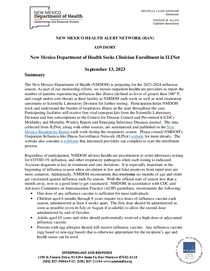 New Mexico Department of Health Seeks Clinician Enrollment in ILINet
Health Emergency Management - General
September 14, 2023
New Mexico Department of Health Seeks Clinician Enrollment in ILINet
Health Emergency Management - General
September 14, 2023
New Mexico Department of Health Seeks Clinician Enrollment in ILINet
 Letter from Governor Michelle Lujan Grisham to U.S. Attorney General Merrick Garland
Injury Prevention - General
September 11, 2023
Letter from Governor Michelle Lujan Grisham to U.S. Attorney General Merrick Garland
Injury Prevention - General
September 11, 2023
Letter from Governor Michelle Lujan Grisham to U.S. Attorney General Merrick Garland
 Governors Proclamation Falls Prevention Awareness Week, Sept 18-22, 2023
Injury Prevention - General
September 1, 2023
Governors Proclamation Falls Prevention Awareness Week, Sept 18-22, 2023
Injury Prevention - General
September 1, 2023
Governors Proclamation Falls Prevention Awareness Week, Sept 18-22, 2023
 Governors Proclamation Suicide Prevention Month 2023
Injury Prevention - General
August 31, 2023
Governors Proclamation Suicide Prevention Month 2023
Injury Prevention - General
August 31, 2023
Governors Proclamation Suicide Prevention Month 2023
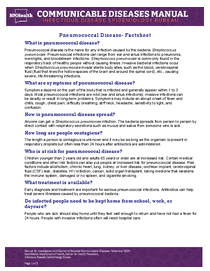 Pneumococcal Disease Factsheet (English)
Infectious Disease Surveillance - General
August 29, 2023
Pneumococcal Disease Factsheet (English)
Infectious Disease Surveillance - General
August 29, 2023
Pneumococcal Disease Factsheet (English)
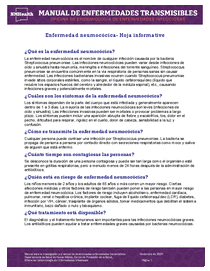 Pneumococcal Disease Factsheet (Spanish)
Infectious Disease Surveillance - General
August 29, 2023
Pneumococcal Disease Factsheet (Spanish)
Infectious Disease Surveillance - General
August 29, 2023
Pneumococcal Disease Factsheet (Spanish)
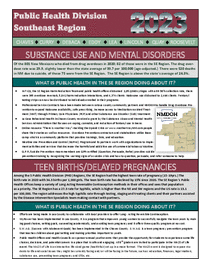 Health Promotion Team – SE Region Legislative Fact Sheet
Health Promotion - General
August 28, 2023
Health Promotion Team – SE Region Legislative Fact Sheet
Health Promotion - General
August 28, 2023
This document explains the mission statement, core values, and health promotion team vision of the Southeast Region Health Promotion Team. Staff and contact information listing.
 Increased Numbers of West Nile Cases in New Mexico in 2023 - August 18, 2023
Health Emergency Management - General
August 28, 2023
Increased Numbers of West Nile Cases in New Mexico in 2023 - August 18, 2023
Health Emergency Management - General
August 28, 2023
Increased Numbers of West Nile Cases in New Mexico in 2023 - August 18, 2023
 Doxycycline Post-Exposure Prophylaxis (doxy-PEP) for the Prevention of Sexually Transmitted Infections
Health Emergency Management - General
August 28, 2023
Doxycycline Post-Exposure Prophylaxis (doxy-PEP) for the Prevention of Sexually Transmitted Infections
Health Emergency Management - General
August 28, 2023
Doxycycline Post-Exposure Prophylaxis (doxy-PEP) for the Prevention of Sexually Transmitted Infections
 COVID-19 Update - Paxlovid Prescribing - August 24, 2023
Health Emergency Management - General
August 28, 2023
COVID-19 Update - Paxlovid Prescribing - August 24, 2023
Health Emergency Management - General
August 28, 2023
As the number of COVID-19 cases rises across the US, the New Mexico Department of Health recommends that providers prescribe Paxlovid (nirmatrelvir/ritonavir) to all appropriate patients diagnosed with COVID-19. Paxlovid, an oral antiviral, is a highly effective treatment for COVID-19 but continues to be under prescribed by providers1. Support for the use of Paxlovid comes from several randomized trials and observational studies of symptomatic outpatients with COVID-19, which demonstrated a reduction in hospitalization and death.


